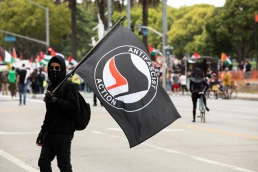The U.S. employee class broadly feels victimized by the last half-century’s neoliberal globalization. Waves of manufacturing job exports, coupled with waves of automation, have mostly brought that class bad news.
by Richard D. Wolff, Brave New Europe
By “class system” we mean the basic workplace organizations—the human relationships or “social relations”—that accomplish the production and distribution of goods and services. Some examples include the master/slave, communal village, and lord/serf organizations. Another example, the distinctive capitalist class system, entails the employer/employee organization. In the United States and in much of the world, it is now the dominant class system. Employers—a tiny minority of the population—direct and control the enterprises and employees that produce and distribute goods and services. Employers buy the labor power of employees—the population’s vast majority—and set it to work in their enterprises. Each enterprise’s output belongs to its employer who decides whether to sell it, sets the price, and receives and distributes the resulting revenue.
In the United States, the employee class is badly split ideologically and politically. Most employees have probably stayed connected—with declining enthusiasm or commitment—to the Democratic Party. A sizable and growing minority within the class has some hope in Trump. Many have lost interest and participated less in electoral politics. Perhaps the most splintered are various “progressive” or “left” employees: some in the progressive wing of the Democratic Party, some in various socialist, Green, independent, and related small parties, and some even drawn hesitatingly to Trump. Left-leaning employees were perhaps more likely to join and activate social movements (ecological, anti-racist, anti-sexist, and anti-war) rather than electoral campaigns.

The U.S. employee class broadly feels victimized by the last half-century’s neoliberal globalization. Waves of manufacturing (and also service) job exports, coupled with waves of automation (computers, robots, and now artificial intelligence), have mostly brought that class bad news. Loss of jobs, income, and job security, diminished future work prospects, and reduced social standing are chief among them. In contrast, the extraordinary profits that drove employers’ export and technology decisions accrued to them. Resulting redistributions of wealth and income likewise favored employers. Employees increasingly watched and felt a parallel social redistribution of political power and cultural riches moving beyond their reach.
Recent Posts
Dems Demand Answers as Trump Photo Disappears From DOJ Online Epstein Files
December 21, 2025
Take Action Now “What else is being covered up?”By Brett Wilkins, Common Dreams Congressional Democrats on Saturday pressed US Attorney General…
Elon Musk Is Vowing Utopia Driven by AI and Robotics. Bernie Sanders Has a Few Questions
December 20, 2025
Take Action Now “I look forward to hearing about how you and your other oligarch friends are going to provide working people with a magnificent life…
U.S. Military Willing To Attack “Designated Terrorist Organizations” Within America, General Says
December 19, 2025
Take Action Now “If I had no concerns and I was confident in the lawful order, I would definitely execute that order.”By Nick Turse, The……
DOJ Won’t Meet Friday Deadline To Release All The Epstein Files
December 19, 2025
Take Action Now The delay means the White House is in apparent conflict with a law President Donald Trump signed in November.By Gregory…




